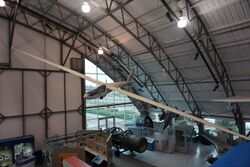Engineering:Glasflügel BS-1
| BS-1 | |
|---|---|

| |
| BS-1 | |
| Role | Glider |
| National origin | West Germany |
| Manufacturer | Glasflügel |
| Designer | Björn Stender |
| Introduction | 1962 |
| Status | Production ended 1969 |
| Produced | 1964-1969 |
| Number built | 20, including two prototypes |
The Glasflügel BS-1, sometimes called the Björn Stender BS-1 or the Stender BS-1, is a West German, high-wing, single seat, T-tailed, FAI Open Class glider that was designed by Björn Stender and produced by Glasflügel.[1][2]
Design and development
The prototype BS-1 was designed by Stender as the initials indicate; the BS-1 was closely based on his earlier Akaflieg Braunschweig SB-6 Nixope, produced whilst he was still an undergraduate. Two prototypes were built by him and his three assistants in 1962. He was then a young engineering student and designed the aircraft at the request of a South Africa n sailplane pilot and industrialist, producing a design that was very advanced for its time. While the designer was test flying of one of the prototypes in 1963 the aircraft suffered an in-flight structural failure and Stender was killed. Glasflügel then took over the project and re-engineered the design, based on their experience producing the Glasflügel H-301 Libelle. The company went on to build 18 production aircraft.[1][2][3]
The BS-1 is constructed entirely from fiberglass and features an 18.0 m (59.1 ft) wing with flaps and dive brakes. For further glidepath control the BS-1 has a tail-mounted parachute. The landing gear is a retractable monowheel.[1][2]
A planned improved model, the BS-1b, was never produced.[2]
Operational history
The BS-1 was considered one of the first soaring "super ships" and was one of the most high-performing gliders of its time, the mid-1960s. Alfred Rohm of West Germany flew a BS-1 to a world 300 km (186 mi) speed record of 135.3 km/h (84 mph) in 1967.[4] Thierry Thys of San Leandro, California flew a BS-1 on a 917 km (570 mi) flight in 1970. At that time it was the third-longest soaring flight ever made.[1][2]
Aircraft on display

Specifications (BS-1)
Data from Sailplane Directory and Soaring[1][2]
General characteristics
- Crew: one
- Wingspan: 18.0 m (59 ft 1 in)
- Wing area: 14.09 m2 (151.7 sq ft)
- Aspect ratio: 23:1
- Empty weight: 310 kg (684 lb)
- Gross weight: 450 kg (993 lb)
Performance
- Maximum glide ratio: 44:1 at 84 km/h (52 mph)
- Rate of sink: 0.543 m/s (106.8 ft/min) at 80 km/h (50 mph)
- Wing loading: 32 kg/m2 (6.5 lb/sq ft)
See also
Aircraft of comparable role, configuration and era
Related lists
References
- ↑ 1.0 1.1 1.2 1.3 1.4 Activate Media (2006). "BS-1 Glasflugel". http://www.sailplanedirectory.com/PlaneDetails.cfm?PlaneID=48.
- ↑ 2.0 2.1 2.2 2.3 2.4 2.5 Said, Bob: 1983 Sailplane Directory, Soaring Magazine, page 79, Soaring Society of America November 1983. USPS 499-920
- ↑ Simons, Martin (2006). Sailplanes 1945-1965 (2nd revised ed.). Königswinter: EQIP Werbung & Verlag GmbH. pp. 258–261. ISBN 3-9807977-4-0. https://archive.org/details/sailplanesndrevi00simo.
- ↑ Air Progress: 18. September 1971.
- ↑ "Glasflügel BS-1 - Frontiers of Flight Museum". flightmuseum.com. http://www.flightmuseum.com/exhibits/aircraft-3/aircraft-7/. Retrieved 15 December 2015.
- ↑ National Soaring Museum (2011). "Sailplanes in Our Collection". http://www.soaringmuseum.org/collection.html.
External links
 |
